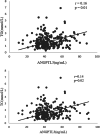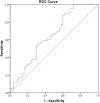The Clinical Role of Angiopoietin-Like Protein 3 in Evaluating Coronary Artery Disease in Patients with Obstructive Sleep Apnea
- PMID: 32440963
- PMCID: PMC7674361
- DOI: 10.1007/s10557-020-06991-1
The Clinical Role of Angiopoietin-Like Protein 3 in Evaluating Coronary Artery Disease in Patients with Obstructive Sleep Apnea
Abstract
Purpose: Hyperlipidemia is the most important early atherosclerosis and coronary artery disease (CAD) indicator. Angiopoietin-like proteins (ANGPTLs) 3, 4, and 8 are lipid dysfunction markers that may be linked to CAD. We investigated whether these circulating ANGPTLs are associated with CAD in patients with obstructive sleep apnea (OSA).
Methods: A total of 327 individuals participated in this study: 221 patients with OSA and CAD, 50 patients with OSA alone, and 56 controls. The Gensini Score was used to assess the severity of CAD. Serum ANGPTL3, ANGPTL4, and ANGPTL8 were measured in all subjects using Human Magnetic Luminex Screening Assay. The independent association between levels of ANGPTLs and CAD was evaluated by multivariate regression analysis.
Results: Serum ANGPTL3 levels were significantly higher in patients suffering from OSA and CAD compared with patients having OSA alone (46.97 ± 13.89 vs 38.25 ± 15.94 ng/ml, P < 0.001). Univariate analysis demonstrated that ANGPTL3 was a risk factor for CAD (OR = 1.72/10 ng ANGPTL3, 95% CI, 1.29-2.28, P < 0.001). In addition, multivariate analysis revealed that ANGPTL3 was independently associated with the presence of CAD (OR = 1.74/10 ng ANGPTL3, 95% CI, 1.29-2.35, P < 0.001) even after adjusting for cofounding factors. Furthermore, circulating ANGPTL3 levels were positively associated with triglyceride (r = 0.16, P = 0.01) and total cholesterol (r = 0.14, P = 0.02) levels, while ANGPTL3 levels had no significant correlation with the severity of CAD. No significant associations were found between the levels of ANGPTL4 and ANGPTL8 and CAD even after adjusting for established risk factors.
Conclusion: Elevated levels of ANGPTL3 were independently associated with a higher likelihood of CAD in patients with OSA. It may be a novel biomarker for OSA patients at high risk of developing cardiovascular diseases.
Keywords: Angiopoietin-like proteins; Coronary artery disease; Lipid metabolism; Obstructive sleep apnea.
Conflict of interest statement
The authors declare that there are no competing interests.
Figures




Similar articles
-
Circulating ESM-1 levels are correlated with the presence of coronary artery disease in patients with obstructive sleep apnea.Respir Res. 2019 Aug 20;20(1):188. doi: 10.1186/s12931-019-1143-6. Respir Res. 2019. PMID: 31429753 Free PMC article.
-
Associations between circulating full-length angiopoietin-like protein 8 levels and severity of coronary artery disease in Chinese non-diabetic patients: a case-control study.Cardiovasc Diabetol. 2018 Jun 25;17(1):92. doi: 10.1186/s12933-018-0736-6. Cardiovasc Diabetol. 2018. PMID: 29940978 Free PMC article.
-
The Clinical Value of N-Terminal Pro B-Type Natriuretic Peptide in Evaluating Obstructive Sleep Apnea in Patients With Coronary Artery Disease.J Clin Sleep Med. 2019 Oct 15;15(10):1403-1409. doi: 10.5664/jcsm.7962. J Clin Sleep Med. 2019. PMID: 31596204 Free PMC article.
-
New insights into angiopoietin-like proteins in lipid metabolism and cardiovascular disease risk.Curr Opin Lipidol. 2019 Jun;30(3):205-211. doi: 10.1097/MOL.0000000000000600. Curr Opin Lipidol. 2019. PMID: 30893111 Review.
-
Circulating angiopoietin-like proteins in metabolic-associated fatty liver disease: a systematic review and meta-analysis.Lipids Health Dis. 2021 May 25;20(1):55. doi: 10.1186/s12944-021-01481-1. Lipids Health Dis. 2021. PMID: 34034750 Free PMC article.
Cited by
-
Investigating the Relationship between Obstructive Sleep Apnoea, Inflammation and Cardio-Metabolic Diseases.Int J Mol Sci. 2023 Apr 6;24(7):6807. doi: 10.3390/ijms24076807. Int J Mol Sci. 2023. PMID: 37047780 Free PMC article. Review.
-
Novel cardiac biomarkers and multiple-marker approach in the early detection, prognosis, and risk stratification of cardiac diseases.World J Cardiol. 2025 Jul 26;17(7):106561. doi: 10.4330/wjc.v17.i7.106561. World J Cardiol. 2025. PMID: 40741019 Free PMC article. Review.
-
The association between biomarker angiopoietin-like protein five and obstructive sleep apnea in patients undergoing bariatric surgery.Sleep Breath. 2023 Aug;27(4):1443-1454. doi: 10.1007/s11325-022-02736-6. Epub 2022 Nov 30. Sleep Breath. 2023. PMID: 36449218
-
ANGPTL3 and Cardiovascular Outcomes in Patients With Acute Coronary Syndrome and Obstructive Sleep Apnea.J Am Heart Assoc. 2022 Sep 20;11(18):e025955. doi: 10.1161/JAHA.122.025955. Epub 2022 Sep 8. J Am Heart Assoc. 2022. PMID: 36073641 Free PMC article.
-
Obstructive Sleep Apnoea and Lipid Metabolism: The Summary of Evidence and Future Perspectives in the Pathophysiology of OSA-Associated Dyslipidaemia.Biomedicines. 2022 Oct 29;10(11):2754. doi: 10.3390/biomedicines10112754. Biomedicines. 2022. PMID: 36359273 Free PMC article. Review.
References
MeSH terms
Substances
LinkOut - more resources
Full Text Sources
Medical
Miscellaneous

